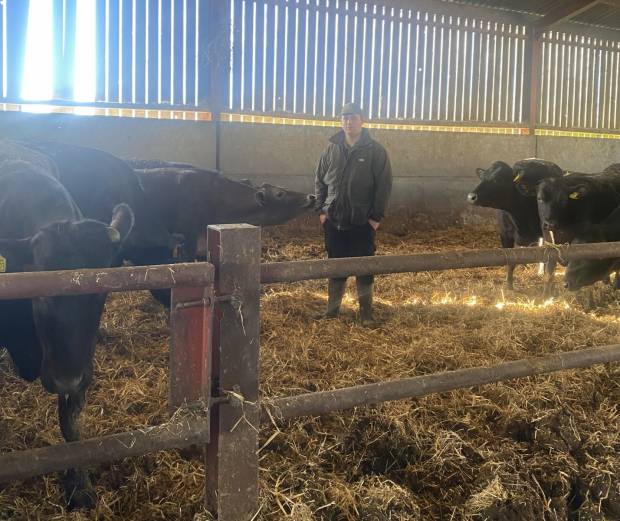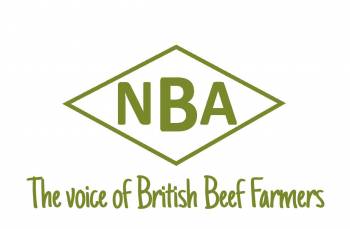NBA Beef Expo Young Farmer Focus Warrendale Wagyu – Jack Thornton
18th March 2024

Jack Thornton aged 20 has been working with Warrendale Wagyu for two years, he started initially as one of their finishers with a batch of 20-month-olds, but has also recently taken delivery of his first batch of Wagyu calves. So now he is very much involved in the whole supply chain.
Jack, who completed his agricultural training at Myerscough College in Lancashire, farms with his father Neil and his Uncle John, across two locations, the 80-acre Jack Nook Farm near Preston, and the 200-acre Thompson Ground Farm just above Hawkshead village, overlooking Windermere. It is Jack who is responsible for the cattle, and he is supported by his partner Samantha, an experienced calf rearer who is now looking after the new venture rearing their first batch of 38 calves.
The cattle enterprise on the Thornton’s Farms is extensive and for the last 25 years, they have been finishing 1000 Continental Cattle for Morrisons. They started rearing and finishing cattle for Warrendale Wagyu approximately 2 years ago, and they currently have 200 head of Wagyu aged between 8 weeks and 24 months old.
Wagyu cattle are sourced from Kirkbarrow Farm, Barton, Tirril, Penrith which is home to George Fabi’s 350+ head dairy farm. Says Jack: “The Fabis have very strong dairy cows, so the Wagyus we get are high-quality beef animals which stand up well in comparison to the Angus for their size and finish.”
Generally speaking, cattle come to them as 6-7 month weanlings, weighing between 250 and 300 kilos, and they stay at Thompson Ground Farm until around 18 months old before returning to Jack Nook for finishing. During the summer they are turned out, but they are wintered inside, when they are fed in the main silage, along with some supplementary feed.
At approximately 20 months old, and weighing between 550 and 600 kilos, they return to Jacks Nook. Here they are finished inside on a combination of Carrs Billington beef mix, homegrown silage, and bought in straw. The overall aim is to finish cattle at 24 months old, weighing between 650 and 700 kilos. “Our strong dairy type Wagyu-crosses are averaging 1.45kg daily liveweight gain (dlwg), whilst a batch of our Jersey Wagyus have recently done 1.07kg dlwg,” says Jack.
Wagyus generally require a slightly longer finishing period which is necessary to achieve the marbling that Wagyu beef is famed for - and this is reflected in Warrendale’s minimum set slaughter age of 22 months. By weighing the cattle monthly, Jack is able to keep an eye on growth rates and he keeps them for as long as they are performing - as a rule of thumb 1.1kg/day - using the Breedr App to record weights, movements, health data, and so on.
“For us finishing and rearing cattle, under a Wagyu contract is simple, and it suits our farms. The Wagyu have really good animals to work with, and effectively we're doing exactly as we've been doing for a very long time, but getting a better price.”
The Thorntons are getting good marbling scores (up to grade 9) which Jack puts down to a combination of good genetics and getting a good start as calves. He receives a breakdown of marble scores from Warrendale which are recorded at point of slaughter using the MIJ (Meat Image Japan) mobile carcase camera. Decent growth rates combined with Warrendale’s bonus of up to 80p per deadweight kilo for extra marbling, means the Wagyus really do stack up in terms of profitability.
To accommodate the Wagyu the Thornton’s have slightly reduced some of the Continentals. “All of our Wagyu go to Warrendale as part of a contract and end up in the shelves of ALDI, Waitrose, and of course, some are sold on light. We still have our Continentals which continue to be sold at Morrisons.
However, in terms of the end price, I like to know what I'm getting, and it is much easier for planning, so I am comfortable in having a mix of two markets.”
Traditionally we would have someone going to market for us five days a week purchasing cattle, but with Wagyu we are guaranteed the stock, we know where they are coming from and when they are arriving. This saves us huge amounts of time and resource.”


